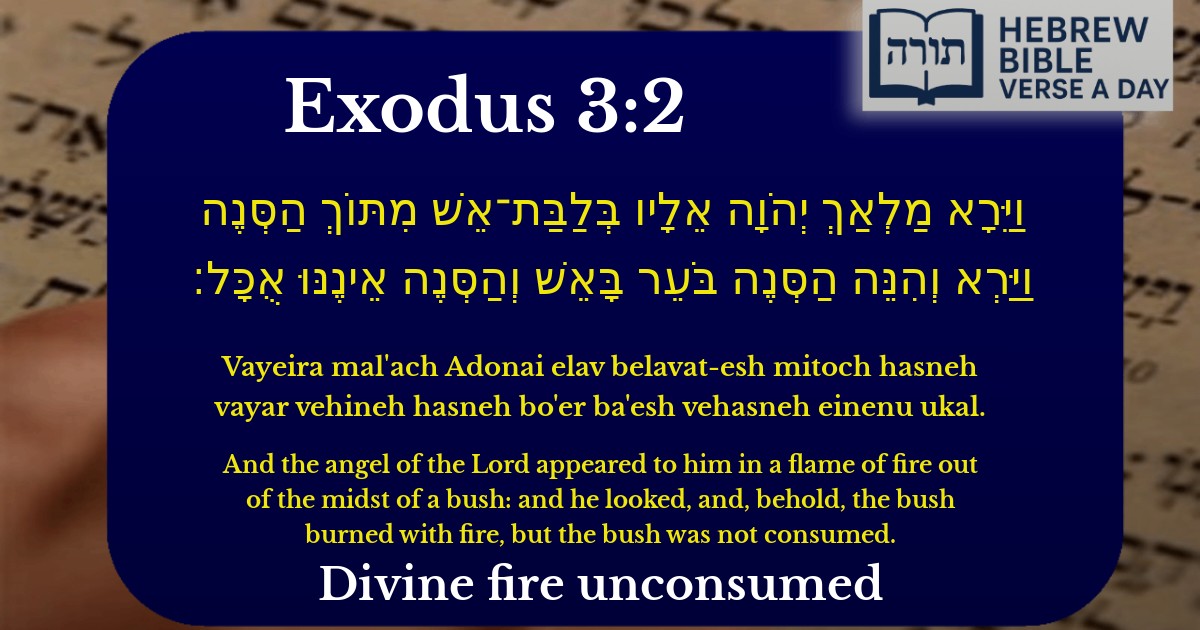Join Our Newsletter To Be Informed When New Videos Are Posted
Join the thousands of fellow Studends who rely on our videos to learn how to read the bible in Hebrew for free!
Hebrew Text
וַיֵּרָא מַלְאַךְ יְהֹוָה אֵלָיו בְּלַבַּת־אֵשׁ מִתּוֹךְ הַסְּנֶה וַיַּרְא וְהִנֵּה הַסְּנֶה בֹּעֵר בָּאֵשׁ וְהַסְּנֶה אֵינֶנּוּ אֻכָּל׃
English Translation
And the angel of the Lord appeared to him in a flame of fire out of the midst of a bush: and he looked, and, behold, the bush burned with fire, but the bush was not consumed.
Transliteration
Vayeira mal'ach Adonai elav belavat-esh mitoch hasneh vayar vehineh hasneh bo'er ba'esh vehasneh einenu ukal.
Hebrew Leining Text
וַ֠יֵּרָ֠א מַלְאַ֨ךְ יְהֹוָ֥ה אֵלָ֛יו בְּלַבַּת־אֵ֖שׁ מִתּ֣וֹךְ הַסְּנֶ֑ה וַיַּ֗רְא וְהִנֵּ֤ה הַסְּנֶה֙ בֹּעֵ֣ר בָּאֵ֔שׁ וְהַסְּנֶ֖ה אֵינֶ֥נּוּ אֻכָּֽל׃
Parasha Commentary
📚 Talmud Citations
This verse is quoted in the Talmud.
📖 Berakhot 7a
The verse is referenced in a discussion about the nature of divine appearances and the significance of the burning bush as a symbol of God's presence that does not consume.
📖 Shabbat 67a
Mentioned in the context of discussing miracles and natural phenomena, highlighting the bush that burned but was not consumed as an example of a supernatural event.
📖 Exodus Rabbah 2:5
Although not part of the Talmud proper, this Midrashic work extensively discusses the burning bush episode, elaborating on its theological implications and the dialogue between God and Moses.


The Appearance of the Angel in the Burning Bush
The verse describes the angel of Hashem appearing to Moshe in a flame of fire from within a sneh (thornbush). Rashi (Shemot 3:2) explains that the thornbush symbolizes Klal Yisrael—just as the bush is lowly and prickly, so too were Bnei Yisrael suffering in Egypt. Yet, despite the fire of oppression, they were not consumed, demonstrating that their suffering would not destroy them.
The Symbolism of the Unconsumed Bush
The Midrash (Shemot Rabbah 2:5) elaborates that the fire represents the nations of the world who seek to destroy Israel, but Hashem ensures their survival. The Rambam (Moreh Nevuchim 1:64) notes that the burning bush was a prophetic vision, not a physical phenomenon, emphasizing that Moshe's encounter was a divine revelation preparing him for his mission.
The Role of the Malach (Angel)
Ramban (Shemot 3:2) explains that the angel served as an intermediary to prepare Moshe for direct prophecy. The Malbim adds that the angel’s appearance in fire signifies that Moshe’s mission would involve both judgment (fire) and redemption (the bush’s endurance).